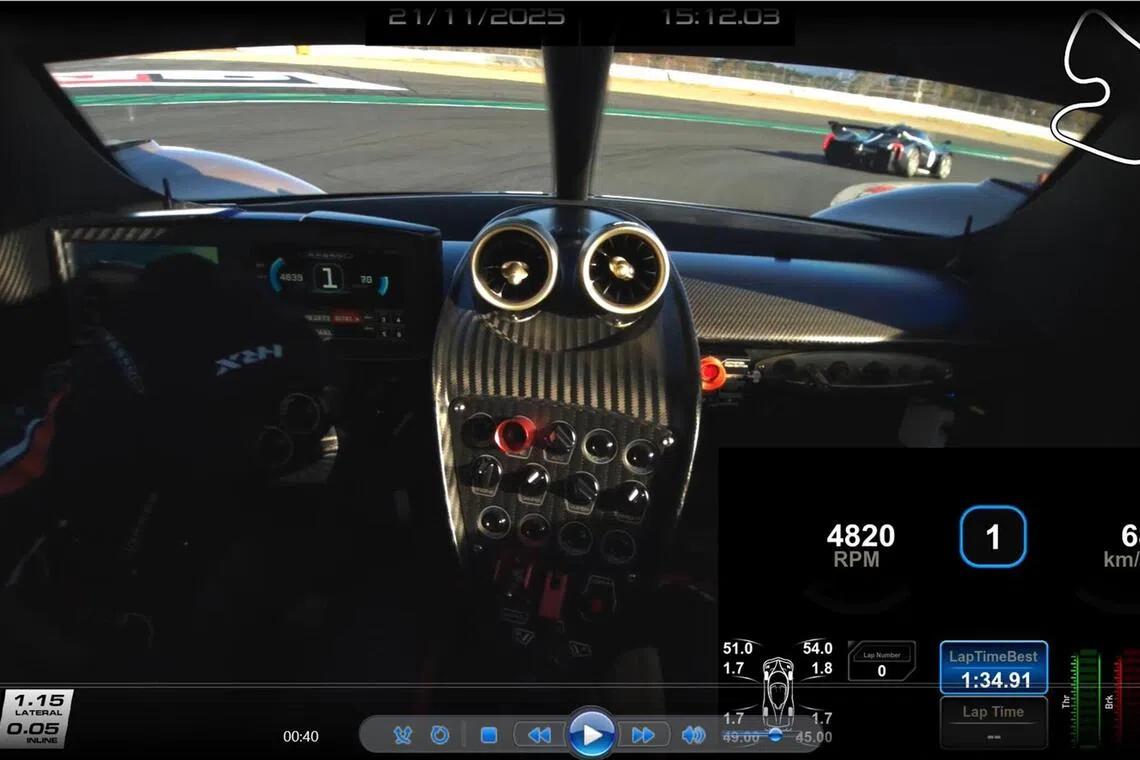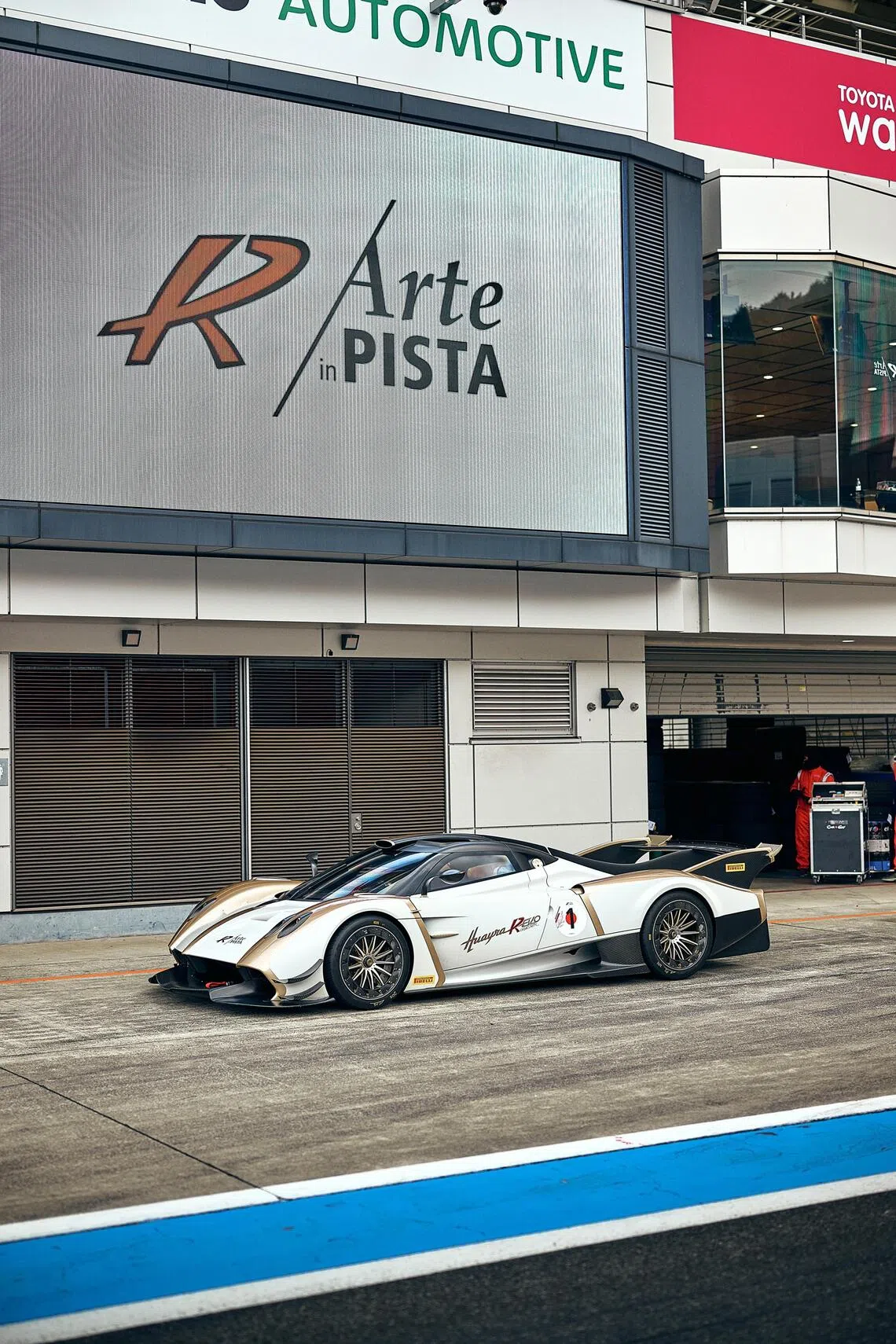Race track experience
Shaken and stirred on Pagani’s ride on the wild side
Sign up now: Get ST's newsletters delivered to your inbox

Vroom with a view: The Huayra R Evo Roadster gaining fast on another car on the track.
PHOTO: PAGANI
Christopher Tan
Follow topic:
OYAMA, Japan – It is 5 deg C at the Fuji Speedway, a race circuit near the foot of Mount Fuji, but I feel a little sweaty. I am in a 4kg race suit, complete with fire-retardant underwear, thick socks that come up to my calves, racing shoes, gloves and a heavily-padded helmet over a balaclava.
Strapped tightly by a six-point harness to the passenger seat bolted to a deep tub in a Pagani Huayra R Evo Roadster, I imagine this is how someone in a straitjacket feels – all dressed up with nowhere to go. Heck, I must be a little insane to have signed up for this. At 66, is my body really up for life in the ulta-fast lane?
Time to find out. Pagani R&D driver Andrea Palma fires up the 900hp track car, which awakens with a seismic roar. The gearbox engages with the thud of a sledgehammer finding its mark. And the car rolls out the garage with the subtlety of an overly flatulent rhino.
Scarcely out of the pit, Mr Palma plants his foot and the featherlight Pagani hurtles towards the first corner. The speedometer climbs towards 200kmh when he slams on the brakes.
My view changes from windscreen to dashboard to window as the first of several ragdoll movements are thrust upon me. At times, my chest feels like a sumo wrestler is kneading dough on it.
The car’s stopping power is so immense, I sense my appendix rising to make the acquaintance of my tonsils. By the third lap, I suspect they are making plans to meet for drinks. In a succession of corners that would unsettle a beached whale, I feel my insides unravelling further.
Somewhere between the second and third lap, where he hits 317kmh on the long straight before applying the mother of all braking, I sense my colon compressing into a semi-colon. The driver must have sensed this too and he turns to give me a thumbs up, shouting: “You okay?”
For all red-blooded males, there is only one response to that. I nod like a headbanger.
The helmet is fairly sound-proof, but the thunderous boom of the Pagani’s high-revving naturally aspirated 6-litre V12 cannot be denied. Certainly not in an open-top car.
It reverberates through the multi-layered headgear to assault my eardrums like a billion angry hornets buzzing through a megaphone. I learn later that the car’s exhaust note reaches 130 decibels, enough to cause hearing damage.

Black and white: The writer suited up before getting into the white Huayra R Evo Roadster in the background.
PHOTO: JAMIE NONIS
The rage-filled track car slides out its rear a couple of times, but the driver puts it back on course with steely coolness. He takes the circuit’s solitary hairpin turn at 56kmh. Other corners are too fast and too furious for me to even glance at the speedometer.
At up to 317kmh on the circuit’s 1.5km-long straight, it is the fastest I have been in a car by a wide margin. But somehow, the thrill of speed is overshadowed by the quick changes in g forces my body is subjected to.
After what seems like a demented roller-coaster ride, we return to the pit. It is here that the car’s telemetry reveals some startling pieces of data.
One, the violent braking at the first turn exerts a force of 3 g (three times the gravitational force of the Earth) – courtesy of racing-oriented Brembo carbon-ceramic brakes. And hard acceleration and cornering exerts up to 1.9 g, respectively.
I have been on other “taxi laps” before, but none quite as brutal as this one. I come away with new respect for race-car drivers – and for the Huayra R Evo Roadster. With 900hp hauling just a tad over one tonne of dry weight, it is, in the words of ex-Formula One driver Andrea Montermini, “basically a monster”.

Pit bull: The monstrous Huayra R Evo Roadster makes 900hp at 8,750rpm, and weighs just over a tonne.
PHOTO: PAGANI
Mr Montermini is head coach of Arte in Pista, a race programme for buyers of Pagani’s track cars. The programme started in 2022 with the Pagani Zonda R and is into its fourth season in 2025. The head coach says Pagani track cars are designed to cater to a broad spectrum of drivers, from novices to experts.
The Huayra R Evo Roadster, for instance, has 12 levels of anti-lock braking system, 12 levels of traction control and five electronic control unit maps. Even the brakes and dampers can be tuned to suit each driver.
At 320kmh, the car’s aerodynamics create more than 1.4 tonnes of downforce to keep the bewinged 5,180mm long, 2,077mm wide and 1,164mm tall vehicle planted on the tarmac. Its 19-inch front and 20-inch rear wheels are shod with Pirelli P Zero slicks.

Top view: The track car’s yoke steering wheel through its open top.
PHOTO: PAGANI
Numbers aside, you might need a driver like Mr Palma to complete the experience. Without a doubt, I have never been so shaken and so stirred.
Should you fancy a similar experience, you must first buy a Pagani track car (available in both right- and left-hand drive). Each car comes with a fixed number of track sessions. Should you want more, you must fork out around €30,000 (S$45,180) for each session, excluding flight and accommodation.
Seems like a lot of money, but look at it this way – you do not need a certificate of entitlement and you do not have to scrap the car after 10 years.
Pagani Huayra R Evo Roadster
Price: From $5.8 million (not for road registration)
Engine: 5,980cc 48-valve naturally-aspirated V12
Transmission: Six-speed sequential with paddle shift
Power: 900hp at 8,750rpm
Torque: 770Nm at 5,800-8,200rpm
0-100kmh: Around 3.2 seconds
Top speed: 350kmh
Fuel consumption: Non-applicable
Agent: Eurokars Supersports
What makes a race driver?
Between laps, I ask Mr Andrea Palma – a seasoned GT race driver who has clocked over 11,500km of race distance – what it takes to become a driver like him.
What is the most important thing to have to be a good race driver?
Passion, determination and fitness. Experience is also important. Experience is how you build skill.
Can anyone become a race driver?
Probably yes, but the difference is that the regular driver can improve with training. But talent is something you are born with. A normal driver has to train a lot to arrive at the point of someone who has that inner skill.
So it is really something you are born with?
Yes.
Follow Christopher Tan on Instagram @chris.motoring

